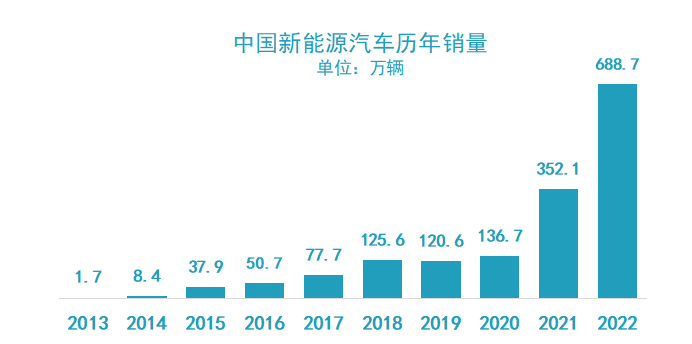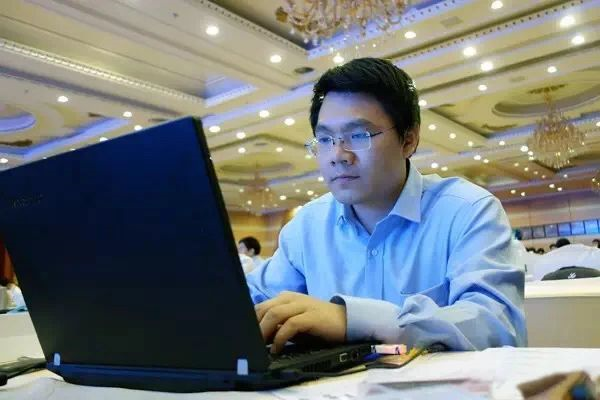Translation
| Author | Qiu Kaijun |
|---|
Editor | Qiu Kaijun
Wishing everyone a happy return to work. I am Qiu Kaijun, founder of “Electric Vehicle Observer”.
Ten years ago, also after returning to work following the Spring Festival, I joined the first electric network and began working in the field of new energy vehicle media. I have been doing this job for the past ten years.
As the proverb goes, a man fears he will choose the wrong profession. I am fortunate to have chosen a good career –
In the past ten years, the new energy vehicle industry has exploded, with annual sales volume rising from just over 10,000 vehicles to nearly 7 million. New energy vehicles have gone from being ignored to becoming a powerful force.
In the past ten years, heroes and legends have emerged one after another, with exciting stories constantly being told. For media professionals, it can be said to be a “gold mine.”
In the past ten years, the integration of new and old industries has led to innovative changes, and industrial competition has escalated. For observers, they only regret that they are not knowledgeable enough to see through the fog.
In the past ten years, I have not only reported on events but also maintained a research and learning attitude, observing the new energy vehicle industry from the perspectives of the automotive industry, industry policies, industrial integration, intelligent organizations, and other angles.
In the past ten years, I worked for the first electric network in the first half and founded the “Electric Vehicle Observer” in the second half. Later, I was also involved in the founding of “Cyber Car”, trying to transition from a core member to an entrepreneur and leader. While reporting on and researching outstanding companies and entrepreneurs in the new energy vehicle industry, I have also been learning from them, learning how to set strategies, define products, and build teams…

Ten years may not be long for many industries, but for the new energy vehicle industry, it is a relatively long “ruler”. Using this ruler, I want to roughly measure:
Which companies can survive longest? Which people can last the longest?
Arbitrage cannot last, but good business can
The driving force behind China’s new energy vehicles is policy.
On the one hand, “new energy vehicles” is a policy term, and the government has defined the scope – pure electric vehicles, plug-in hybrids (including extended range), and hydrogen fuel cell vehicles.
On the other hand, without policy guidance and subsidy stimulation, new energy vehicles would not have risen so quickly, and Chinese car companies would not have the current leading edge.The dividends of policies undoubtedly attracted a group of profit-driven individuals who did not follow the logic of doing business, but only focused on taking advantage of the policies.
One typical example is the subsidy fraud between 2015 and 2016. The Ministry of Industry and Information Technology has at least announced two batches of fraudulent enterprises. However, it is believed that there are far more in the industry. There was a fake subsidy list circulating, involving 93 car companies, which is just the tip of the iceberg.
Such companies basically disappeared after the crackdown on subsidy fraud. Although the subsidies were still available and the intensity was still great, new energy vehicles gradually returned to the essence of doing business.
There are also some state-owned enterprises that take new energy vehicles as political achievements and violate economic laws, making it ultimately unsustainable.
Only companies that treat new energy vehicles as a business have persisted into the post-subsidy era.
Doing business may sound low and without as many value labels, but it is more durable, reliable, and long-lasting. Since doing business requires R&D investment, building high-quality products, establishing excellent teams, and protecting brands, which can provide sustained competitiveness for companies.
BYD can be said to be the company that has enjoyed the largest policy dividends in the past decade, but its current advantages are still based on the development of its three electric systems, supply chain and production organization, and brand recognition.
CATL has risen to become the world’s largest power battery company with the support of policies, but its strength in research and development, product competitiveness, scale, and advantages are even more critical.
Ideal, NIO, and others frequently mention gross profit and business model and rarely discuss the concept of building a strong automobile country and national brand. However, only such companies can persist.
Recently, some people have used internet language to describe entrepreneurs like Musk and Li Xiang as “super product managers” with greater advantages. In fact, the responsibilities of a product manager such as identifying needs, defining products, organizing development and operation are not newfangled things, but the entrepreneur spirit that economists talk about.
Speculators fade away, but the entrepreneur spirit lasts.
Marketing is difficult to sustain the charge, while R&D builds a moat
In the new energy era, we can hardly see “marketing heroes” anymore.
With the emergence of new energy vehicles on a large scale, automobile consumption has peaked. Previously, independent brands took advantage of the opportunity to enter households and replace imports, and those who expanded their marketing network quickly and had stronger incentives could sell more cars and create a group of marketing geniuses.
However, in the new energy era, it is either a bloody battle of overwhelming cost advantages or a unique breakthrough in capturing needs and successfully positioning products, with a disruptive channel. No one knows where the “marketing heroes” are, as Musk, Wang Chuanfu, Li Xiang, and Li Bin endorse and sell their products.After the new energy vehicles entered the market, marketing highlights emerged, such as the rapid rise of Eureka brand. But individual breakthroughs cannot be sustained. The long-term competitiveness of enterprises in the field of new energy vehicles is comprehensive: development leads the way, supply and production build bridges, and marketing engages in warfare.
In the era when automobiles are mechanical industrial products, marketing is more important; as cars become intelligent terminals, research and development, supply, and production become more important. As the software properties of automobiles continue to increase, the importance of research and development will also rise.
In the past decade, whoever invested more and produced more in the development of the “three electric” technology has gained the most, with successful examples from Tesla and BYD, which were a great release of technology dividends.
In the next decade, whoever invests more and produces more in intelligent development may reap the biggest reward.
TO VC Is Not Sustainable, TO C Is the Right Way
New energy vehicles have long been a trend, attracting capital investment and leading to the emergence of a batch of TO VC (venture capital-oriented) enterprises.
TO VC enterprises like to tell stories, build models, benchmark, draw PPTs … fundamentally, they play the game of pass the parcel with investors’ money.
They may be able to get angel rounds, A rounds, and B rounds of financing, but they cannot avoid the market’s validation, nor can they evade the scrutiny of truly savvy investors. Many new car manufacturing enterprises, new energy vehicle operating enterprises, innovative charging and exchange operating enterprises, and self-entertaining technological innovation enterprises have disappeared from our vision because of this reason.
I believe that the government and society’s emphasis on “innovative models” is wrong. “Innovative models” have constructed a “bullshit” system for TO VC.
I also believe that there has never been a situation where “the wool comes out of the dog’s body and is paid for by pigs”. If you make money from someone, you must provide quality products and services to them and solve their problems honestly, only then will you achieve long-term return.
In other words, only TO C (consumer-oriented) is the right path. A typical example is Ideal Automobile, which did not produce pure electric vehicles that investors wanted, but instead produced range-extenders that met the needs of consumers. Although it was almost bankrupted, Ideal Automobile’s subsequent development proved that TO C is fundamental and will eventually win support from the capital market.
Of course, some startups are Moon Shoots, wildly daring and unattainable, relying solely on capital support for a long time until the day when the time is ripe. Tesla, led by Elon Musk, is one example. But remember, Tesla had a Master Plan very early on, and Musk had long said how to make money TO C.## Personal heroes are easy to decline, while intelligent organizations endure
In the past ten years, many heroes emerged. But who is still in the center of the stage?
Undoubtedly, we have witnessed many outstanding individuals who pursued their dreams and led their industries with remarkable achievements for several years. However, some private entrepreneurs had impure motives or insufficient perseverance, which led to their sudden departure; while some state-owned enterprise executives utilized the platform and made brave attempts to explore new territories, but the limitations of the bureaucratic system hindered the continuous growth of their business.
Moreover, the competition has intensified, from traditional cars to smart electric vehicles, from incremental market to personalized consumption. This is a team event, not an individual competition.
As we can see, some indigenous brands that rose to fame in the past are now struggling to survive in the tide of new energy vehicles. Even those who achieved millions of sales are now experiencing painful transformation. Leaders are worried, while middle and lower-level staff are loyal. However, individual efforts must be transformed into organizational power. Only by enabling the entire company to become intelligent can each “tentacle” quickly perceive, decide, and execute under a common vision, values, and methodology, which can adapt to future competitions.
Entrepreneurs must invest more effort in building organizations. Even Steve Jobs had passed away, his goal of building a great company has not yet failed.
Insufficient experience is not enough, lifelong learning is the norm
In the past decade, electrification and intelligence technologies have advanced rapidly. Many playbooks for new energy vehicles have become outdated, and new solutions through industrial integration have emerged. I have made countless mistakes as well.
As Kevin Kelly said, the world is always becoming, and we are forever ignorant. Eventually, we will be replaced like the old people who cannot use smartphones today. To delay this moment, we must always be in a learning state, regardless of age and stage.
The above is a summary of ten years of observation. Because I believe in the unlimited potential of the new energy vehicle industry, I propose this conclusion for future reference.
Finally, I want to express my gratitude to many pioneers and friends in the new energy vehicle industry for their tolerance, help, and support for me and my publications “Electric Vehicle Observer” and “Cyber Car”.
To all colleagues in the new energy vehicle industry and media, see you in the next decade.
This article is a translation by ChatGPT of a Chinese report from 42HOW. If you have any questions about it, please email bd@42how.com.
